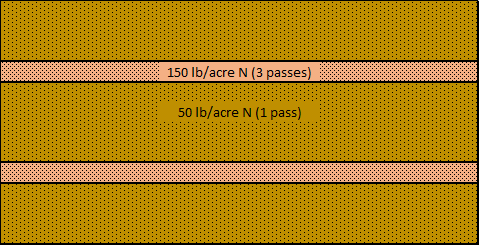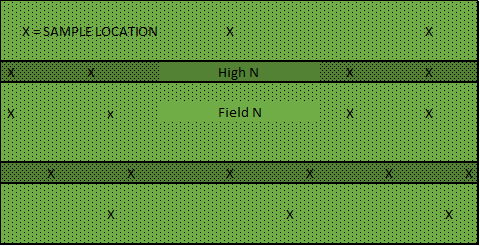Recent UCCE research has illustrated the value of in-season applications of nitrogen (N) fertilizer, particularly applications made at the early vegetative growth stages. This is typically the stage of growth when N demand from the crop is increasing rapidly, the soil is beginning to warm up, and microbial metabolism and associated mineralization/transformations of the various forms of N are increasing. Over a wide range of California conditions and across multiple seasons, applications of N fertilizer at this stage of growth have been shown to increase grain yield and protein and improve fertilizer use efficiency relative to equivalent amounts of N applied pre-plant. Therefore, a strategy that prioritizes in-season applications of N fertilizer over pre-plant applications is a good starting point for getting the most out of your N fertilizer.
The decision to save the majority of your N budget for an in-season application also creates an opportunity to determine whether and how much N fertilizer to apply during a topdress application with more precision. N-rich reference strips are a relatively simple way to determine the need for N in a site-specific manner at the time of the topdress application. This approach has been used with some success in other parts of the US, but is not typically used here in California. Combining a N-rich reference strip with simple tools that measure the soil nitrate status and the relative crop N status via canopy and leaf sensors is the best way to make a precision N topdress decision with confidence.
UCCE agronomists are interested in assisting growers with implementing N-rich reference strips in the coming season. The general principles for using N-rich reference strips to inform N management in wheat are as follows:
1) For a given N fertilizer budget, consider applying 1/3 of the N budget pre-plant and saving 2/3 of the budget for an in-season topdress application.
2) During the pre-plant application, make a double or triple pass across the field in an area(s) that will be generally representative of the entire field (see below). For example, if your pre-plant field rate is 50 lb/acre N, make a triple pass in one or two strips so that the pre-plant application in the N-rich strip is 150 lb/acre N.
3) At the early vegetative growth stage (tillering), measure the plant-soil environment in representative areas of both the N-rich reference strip and the larger field.
- Soil nitrate-N concentration in the top foot is the best predictor of crop response to N fertilizer applications at this stage of growth. Soil nitrate can be determined via a lab value or with less precision but greater speed by using a soil nitrate quick test.
- Canopy greenness as measured by NDVI can indicate whether the crop canopy is currently showing signs of N-deficiency relative to the reference strip. The Trimble Greenseeker is an example of an easy to use and relatively inexpensive NDVI meter.
- Tissue N concentration of leaf samples taken from both the N-rich area and the larger field can also indicate whether the main crop is N-deficient relative to the reference strip. Leaf chlorophyll meters such as the atLEAF chlorophyll meter return values that are closely correlated to tissue N concentrations and provide information on the spot. Tissue analysis from a lab would also be a suitable approach that would produce similar information as a chlorophyll meter.
4) Each of these tools/tests can help to detect differences in N status that are not obvious to the eye. By comparing the values in the reference strip to the values in the broader field, the need for and quantity of the topdress N application can be specified with more confidence. Because each of the above indicates N status from a different scale of the plant-soil continuum, a precision management decision can be made with the greatest degree of confidence when the full suite of measurements are taken. Nevertheless, each of these measurements can provide useful and actionable information on their own.
Because residual soil N, rainfall and rotation effects can differ from year-to-year and field-to-field and soil type can differ both within and across fields, the N-rich strip helps to correct for some of these site- and year-specific differences. It also serves as a local calibration point for the tests and devices used to measure N availability. In addition, UCCE research has produced algorithms in a research context that can inform whether and how much N to apply based on values obtained following steps 1-3.
We are keen to apply and validate these in on-farm settings and are looking for cooperators willing to try out this approach in the coming season. We can assist in implementing N-rich strips and taking in-season measurements on a limited number of fields. If you are interested in setting up a N-rich strip in the coming season and would like to discuss further, please reach out to Konrad Mathesius in the Woodland UCCE office or Mark Lundy at UC Davis.

